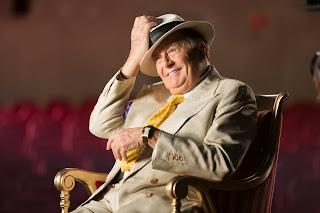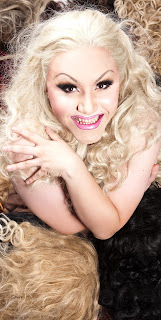 |
The Silk Moth 2014
Photo by Barbie Robinson |
 |
Sapling to Silver 2011
Photo by Barbie Robinson |
 |
Elizabeth Cameron Dalman June 22, 2015
Photo by Helen Musa |
Elizabeth Cameron Dalman OAM – In Conversation with the Canberra Critics’ Circle. Canberra Museum and Gallery, June 22, 2015.
A Sort-of Report by
Frank McKone
At the first of four Winter Conversations planned for this year, chaired by our founder Helen Musa
OAM, a baker’s dozen of Canberra’s critics across the arts of dance, literature, visual art and theatre interrogated a doyenne of modern dance in Australia, Liz Dalman.
Of course, I use the term ‘interrogated’ in the purely academic sense. The conversation was conducted in an atmosphere of warmth and great respect for a dancer, choreographer and artistic director of such long-standing originality and drive. Now an octogenarian, Liz Dalman still performs while even Martha Graham’s last performance was when she was a mere 76. (
https://en.wikipedia.org/?title=Martha_Graham)
Mention of Martha Graham was significant, as Dalman recalled that Graham had been strongly influenced by her study of Asian, particularly Chinese, dance forms; and now Dalman is directing Taiwanese performers for whom the Graham Technique is taken as essential in their training in Taiwan.
Cultural change away from the European ballet tradition, in which Dalman was first trained, was the key to her setting up the Australian Dance Theatre (ADT) in her home town, Adelaide, in 1965 after her lengthy overseas experience, especially in Holland.
To fill in with a little local colour, I rang Anton Witsel
CAL, OAM, who was a solo character dancer in the Nederlands Dance Theatre (NDT) from 1948 and later taught mime and movement at NIDA and lectured in Theatre Practice for the erstwhile Goulburn College of Advanced Education (including teaching Critics’ Circle members Bill Stephens and myself, and Canberra Theatre Education Impresario Tony Martin).
Ton recalled Liz Dalman performing and teaching in the Scapino Ballet and Scapino Dance Academy directed by Hans Snoek. Witsel explained that at that time it was a small coterie of dancers world-wide who were involved in the changes in modern ballet and modern dance, and Australia, with the encouragement of Dalman’s parents – Sir Keith Cameron Wilson and Lady Wilson – received not only Witsel himself, but Liz and her husband Jan Dalman (famous for photographing Marcel Marceau), and also Jaap Flier (founding member of NDT) who worked with Liz at the ADT and was guest artist for The Dance Company (NSW), which had been founded by Sue Musitz in 1969. Graeme Murphy became director in 1976 and renamed it the Sydney Dance Company in 1979.
Google
Jan Dalman,
Elizabeth Cameron Dalman and
Jaap Flier for much much more, showing how important was the connection between the Netherlands and Adelaide in the early 1960s for the development of modern dance in Australia. Though Liz Dalman worked with and was taught by many people, she made special reference to Eleo Pomare, described in Wikipedia as “a Colombian-American modern dance choreographer known for his politically charged productions.” As a mentor, he passed on to Liz three themes for her work:
1.
Intention – in any work, there must be an intention to communicate something through the dance. I took this to suggest that even though, as Liz said when we spoke one-on-one, pure dance for the sake of dancing is a legitimate form, for her it was necessary for her dances to convey meaning about something of importance to society.
2.
Breaking from convention – to have intention means that rigid conventions need to be broken. An example which arose in the Conversation concerns body shape. Where traditional ballet required women and men of the ‘correct’ size and shape, modern dance – not for the sake of being unconventional – needed to have a wide variety of bodies on stage to represent social themes. A recent example, in the 2015 Sydney Festival, was Force Majeure’s
Nothing to Lose, performed by fat dancers as an exposé of how fat people are treated and, in the process, showing how common assumptions were challenged by fat people creating powerful expressive dance.
3.
Dancing the Environment – this is the term I have coined to describe not just Dalman’s works about environment issues, but her working in places (such as Weereewa, Lake George) or on stage with dancers from different cultures in such a way that the dance incorporates the physical, historical, social and cultural setting, and in doing so illuminates the past and the present and becomes the expression of intention.
In the Conversation it seemed to me that this third element in Dalman’s work had especially developed as she created dance with Indigenous people, beginning with meeting the poet Oodgeroo Noonuccal (Kath Walker) and particularly after a productive stay in a Western Desert Pitjantjatjara community; as well as through a study on location of the Darling River from Wilcannia, Broken Hill and down to the junction with the Murray.
Bride of the Desert and
River were works of cultural and environmental issues which resulted. Their value may have been questioned at the time, but their significance is clear today.
Being a Conversation, and therefore with no formal speech, a number of points of interest were raised. About the relationship between music and dance, Dalman explained she had no regular approach. Music may create a feeling which she may express in the dance; an image and movement may be the starting point and music found or composed to fit; or dance may happen without music – sparking memories from people of Merce Cunningham’s silent dance in his 1976 tour of Australia. “Dancers must be able to count!” was an amusing aside at this point.
The key for Dalman, she said, was not to respond to music at a superficial level, but to “go into the layers underneath the music.”
This need for total integration of all the elements of a work reappeared in discussion of the use of multimedia. The issue for Dalman was that projection and live video could too easily have the effect of diminishing the dancer’s work, and, again in one-on-one conversation, she agreed that there is a learning process needed to find the “balance between technology and choreography”. This year’s Sydney Theatre Company production of Tennessee Williams’
Suddenly Last Summer was a good example of successfully finding that balance in theatre, for a play where live video might not be expected to be appropriate.
Though many other topics arose, including discussing to what degree there is an onus placed on artists to deal with “issues”, perhaps I should finish on a political note. At one point, when ADT was setting up a grand tour to completely new places – Papua New Guinea, South-East Asia and India in 1971 – Liz Dalman was on the point of mortgaging her home to provide the necessary funds. Fortunately the Elizabethan Theatre Trust and Qantas came to the party on that occasion. Yet still today she is having to self-fund her Mirramu Dance Company’s tour to Adelaide. I just wondered where our grandstanding Arts Minister / Attorney-General George Brandis fits in. Will the Australia Council have the funds to come to this party? Or Brandis’ new National Program for Excellence in the Arts?
It was sad that all Elizabeth Cameron Dalman
OAM, at 81, could do in response to my question, after a career which she says began at the age of three, was a gentle shake of the head.
 |
Liz Dalman 1967
Photo by Jan Dalman |
Addendum
If you have read the first version of this article, you will notice a reference to Isadora Duncan's brother. I thought I heard that Elizabeth had been taught by him, but here's an update in which she clarifies my misconception:
The story was that Margaret Morris, an English pioneer of modern dance studied
with Raymond Duncan just after Raymond and Isadora came back from their ground
breaking trip to Greece. Margaret then incorporated some of these new
variations, that Isadora had developed, into her Margaret Morris (MMM)
technique. My first dance teacher Nora Stewart travelled regularly in the 1920's
to London. There she studied with Margaret Morris and learnt this MMM technique.
As well as teaching the Russian style of classical Ballet Nora also taught
Margaret Morris dancing. This is where as a young school girl, I first studied
it. Looking back now I do appreciate the lineage and connection to Isadora even
though it was not a direct one.
By email 28 June 2015














